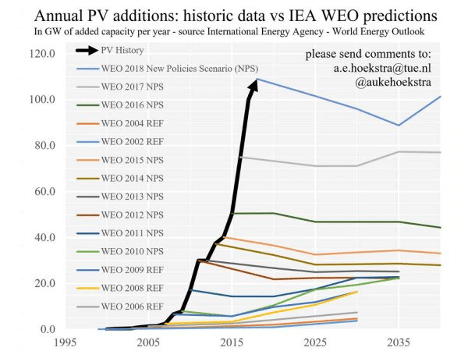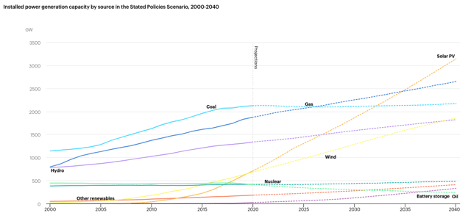Something strange has happened at the International Energy Agency (IEA) — the agency has finally begun to take solar and other renewables seriously.
The IEA annual World Energy Outlook (WEO) is perhaps the world’s most respected energy forecast. They’re not modest with their own description of the WEO: “The world’s most authoritative source of energy-market analysis and projections”
It’s a massive report and costs a goodly sum to purchase the full version. The executive summary is free. The latest one is here.
The IEA is the energy watchdog for the wealthy and mostly western nations in the Organization for Economic Cooperation and Development (OECD), now comprised of 37 nations.
IEA’s solar PV forecasts have been inexplicably and wildly wrong, year in and year out, as demonstrated by Auke Hoekstra’s chart from last year (each colored line is the projected amount of solar for that year, changing steadily upward in each year’s new report):

This chart shows that for every year since 2002 the WEO solar forecasts have been wrong, and, in almost every year, from the very first year of the forecast. This is because solar has grown far faster even in the first year of the forecast period than most of the forecasts project for 25 years later. That’s not just wrong. That’s catastrophically and laughably wrong. Year in and year out.
So why have these forecasts been so wrong? This would be a real mystery for any reputable forecasting entity, let alone the OECD’s official energy watchdog.
I asked Hoekstra himself why he thinks IEA has gotten it so wrong. Here is his answer.
IEA says “it’s not a prediction/forecast and that everybody is using it that way is not their problem. It’s a scenario assuming current policies are kept and no new policies are added. Many people have pointed out that they are still very wrong if you try to account for that but no reactions from IEA to that as far as I can tell.”
He adds that “the discrepancy basically implies that every year loads of unplanned subsidies are added while that is not always the case but so far I know of no reaction to those criticisms either. So it boils down to: it’s not a forecast and any error you find must be attributed to that. And no you cannot see how the model works.”
The IEA website explains the WEO process: “The detailed projections are generated by the World Energy Model, a large-scale simulation tool, developed at the IEA over a period of more than 20 years that is designed to replicate how energy markets function.”
Clearly there’s a rather large discrepancy between IEA’s perception of its forecasting accuracy and its actual accuracy.
IEA finally wakes up
But here’s the good news: IEA has finally, in its 2019 report, begun to take solar and other renewables seriously. They’ve created two new “scenarios” in their modeling and made them the focus of the WEO: 1.) Stated Policies Scenario, which as you might guess represents existing commitments to renewables; 2.) Sustainable Development Scenario, which represents a more ambitious set of policies considered necessary to meet climate mitigation goals – achieving more than twice the global greenhouse gas emissions reductions by 2040, compared to the SPS.
The executive summary of the 2019 WEO states:
Cost reductions in renewables and advances in digital technologies are opening huge opportunities for energy transitions, while creating some new energy security dilemmas. Wind and solar PV provide more than half of the additional electricity generation to 2040 in the Stated Policies Scenario and almost all the growth in the Sustainable Development Scenario.
Recognizing that even stated policies will lead to renewables being “more than half” of additional electricity by 2040 is a major step forward. And it seems likely that nations of the world will steadily adopt more ambitious green energy goals as they realize that green energy is already cheaper than fossil fuel and nuclear energy in most circumstances, so there’s very little political risk in adopting steadily more ambitious green energy goals.
Here’s the “money” chart from the new report, showing that in the Stated Policies Scenario solar PV becomes the world’s largest source of energy by 2040:

Why did this change happen? We still don’t know. But it’s likely that Hoekstra’s frequent heckling of the absurd WEO forecasts for solar played a role in this shift. Gadflies do achieve large-scale change sometimes – particularly when they multiply.
The views and opinions expressed in this article are the author’s own, and do not necessarily reflect those held by pv magazine.
This content is protected by copyright and may not be reused. If you want to cooperate with us and would like to reuse some of our content, please contact: editors@pv-magazine.com.








It is still pretty laughable that coal generated electricity is forecast to continue its current generation level over the next 20 years. (Or sad if it does)
Even in their North American stated policies they have coal still having 67% of 2018 demand by 2030 and 57% of 2018 demand by 2040. This is pretty absurd. With their Sustainable policy it goes to 16% of 2018 demand by 2030 and 10% by 2040.
My swag forecast is that North American coal demand will be down to 67% by 2023, 57% by 2025 and 16% by 2030.
The death spiral of coal in NA is very real and the demand destruction will accelerate. Even now look at all the coal bankruptcies among coal producers and coal generators. A huge swath of coal mining has lost economies of scale. They are having to pay for the same amount of equipment, but digging less coal.
And, then you look at the supposed coal growth countries like Vietnam which installed 5GW of solar last year. And, S Korea which is curtailing coal because of pollution. And Australia which had 9x proposals for the RE zone in NSW.
I think world solar installed capacity will double by 2025 from current estimate of 583GW to 1200GW. Wind generating capacity will also grow since off-shore wind is pretty much in its infancy.